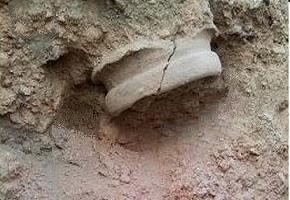 |
| Pitcher found at Shiloh |
The city, once
the capital and religious center of ancient Judah, was captured by the
Philistines, according to the account in the biblical Book of Samuel. However, the text never explains what
happened to Shiloh.
The pitcher has been dated to around 1050 B.C.E., matching the approximate date of the city’s demise.
The pitcher has been dated to around 1050 B.C.E., matching the approximate date of the city’s demise.
To many
religious people, archaeological support for a biblical account comes as
welcome news. After all, believers seem
to think that historians deliberately ignore the Bible or continually try to
prove everything in it is not true. They
are sure the Bible is accurate and that scholars just can’t stand that idea.
 |
| Michalski |
They are wrong.
"Science
is special because we are allowed to change our minds," explained Joseph Michalski, of the Planetary Science Institute in
Tucson, Ariz., and London's Natural History Museum. He was speaking in another context – an
exploration of Mars – but the concept is the same.
Religion has no room for doubts or revisions. Science must.
Scholars simply
want to find out the truth the same as everyone else. That’s why there are multiple archaeological
digs. This one, for example, also showed
that after the city burned down, people came back and stayed until the
Assyrians conquered the land in 722 B.C.E.
However, Shiloh was never again a cultural center or home to the Ark of
the Covenant. Samuel forgot to mention
that tidbit in his report. In fact,
Shiloh is never mentioned again in the Bible after it was burned down.
While believers
in the validity of the Bible may rejoice at this finding, it’s really a
two-edged sword. Accepting the historical
support in this instance requires the acceptance of historical evidence that
contradicts other biblical claims.
Picking and
choosing between archaeological findings makes no sense. The same techniques are used in all
situations to determine what happened.
If it belies faith, that’s the way it is.
 |
| Albright |
And that’s the
way it’s been since archaeologists first began to look for historical evidence
of biblical stories. William Albright,
an American archaeologist, led the effort, starting in the 1920s.
He called the
effort biblical archaeology, because he recognized that donors were more likely
to fund a vain search for Noah’s Ark than a valid effort to uncover evidence of
the ancient Sumerian civilization.
Unfortunately for Albright and those who have followed in his footsteps, very little has turned up that validates biblical writings.
Unfortunately for Albright and those who have followed in his footsteps, very little has turned up that validates biblical writings.
That doesn’t
mean the evidence doesn’t exist. An
archaeological maxim states that absence of evidence does not mean absence of
evidence. If someone can’t find proof,
that could mean the proof is still hidden.
However, the more than 150-years of digging in
what was once ancient Israel has turned up a lot of evidence that clearly
contradicts the religious texts.
 |
| Wall-less ruins of Jericho |
For example:
1.
Joshua couldn’t have brought down the walls at
Jericho. There never were any massive walls
there.
2.
Ai, a city Joshua supposedly destroyed, was in ruins had
been for hundreds of years before the Israeli leader and his army could have
gotten there.
3.
No evidence of an Exodus from Egypt has ever been found,
including evidence that anyone lived in the Sinai or anyone invaded Canaan in the required time period.
4.
No evidence of a Garden of Eden, Noah’s Ark or anything
cited in the Bible prior to David has ever been uncovered.
The list could go on, but it doesn’t matter. Archaeologists will continue to dig up the ancient past. Some of it will definitely contradict the Bible. Some of it may support a biblical story. None of it will be conclusive, not for believers or for scientists.
That’s what
makes the searching so interesting.
Long-time
religious historian Bill Lazarus regularly writes about religion and religious
history. He also speaks at various
religious organizations throughout Florida.
You can reach him at www.williamplazarus.net. He is the author of the famed Unauthorized
Biography of Nostradamus; The Last Testament of Simon Peter; The Gospel Truth: Where Did the Gospel
Writers Get Their Information; Noel:
The Lore and Tradition of Christmas Carols; and Dummies Guide to Comparative
Religion. His books are available on Amazon.com,
Kindle, bookstores and via various publishers.
He can also be followed on Twitter.
You
can enroll in his on-line class, Comparative Religion for Dummies, at
http://www.udemy.com/comparative-religion-for-dummies/?promote=1
No comments:
Post a Comment